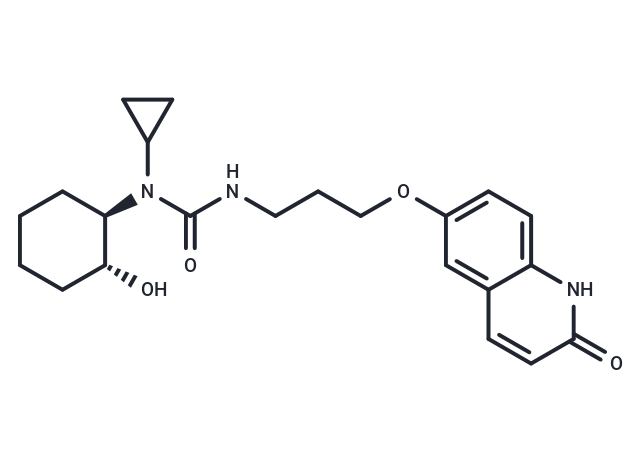Shopping Cart
- Remove All
 Your shopping cart is currently empty
Your shopping cart is currently empty

K134 is an inhibitor of phosphodiesterase 3. The IC50s of K134 for PDE3A, PDE3B, PDE5, PDE2 and PDE4 are 0.1, 0.28, 12.1, >300 and >300 μM, respectively.

| Pack Size | Price | Availability | Quantity |
|---|---|---|---|
| 25 mg | $1,670 | 6-8 weeks | |
| 50 mg | $2,180 | 6-8 weeks | |
| 100 mg | $2,800 | 6-8 weeks |
| Description | K134 is an inhibitor of phosphodiesterase 3. The IC50s of K134 for PDE3A, PDE3B, PDE5, PDE2 and PDE4 are 0.1, 0.28, 12.1, >300 and >300 μM, respectively. |
| Targets&IC50 | PDE3B:0.28 μM, PDE3A:0.1 μM, PDE5:12.1 μM |
| In vitro | K134 (K-134) inhibits rat and mouse platelet aggregation induced by collagen and ADP in a dose-dependent manner in vitro (IC50s: 5.5 μM and 6.7 μM for mice, respectively). The half-maximal (50%) inhibitory concentration (IC50) values of K134 are 2.5 μM and 3.2 μM, respectively [1]. |
| In vivo | K134 obviously decreases the incidence of occlusive shunt thrombi at doses above 10 mg/kg (half-maximal effective dose: ED50=11 mg/kg). The effects of PDE3 inhibitors on thrombus formation are also investigated in an arteriovenous shunt model in rats. The plasma concentration of K134 is 0.43±0.08 μM (Cmax) at a dose of 10 mg/kg. K134 obviously prolongs middle cerebral artery (MCA) occlusion time at doses >10 mg/kg and decreases cerebral infarct size at 30 mg/kg in the stroke model (n?=?12, 87.5±5.6 vs. 126.8±7.5 mm3, P<0.01), indicating its potent antithrombotic effect. The overall bleeding risk of K134 is assessed in general in mice. K134 (30 mg/kg; Single oral administration) does not prolong bleeding time at a dose of compared to control (106±5 vs. 110±5 s, not significant). A sufficiently high enough plasma concentration of K134 (13.6±2.3 μM) is detected to inhibit platelet aggregation at 10 min after single administration in mice at a dose of 30 mg/kg, which is the same time point as the above test of bleeding time [1]. |
| Alias | OPC33509 |
| Molecular Weight | 399.48 |
| Formula | C22H29N3O4 |
| Cas No. | 189362-06-9 |
| Relative Density. | 1.29 g/cm3 (Predicted) |
| Storage | Powder: -20°C for 3 years | In solvent: -80°C for 1 year | Shipping with blue ice. |

Copyright © 2015-2025 TargetMol Chemicals Inc. All Rights Reserved.